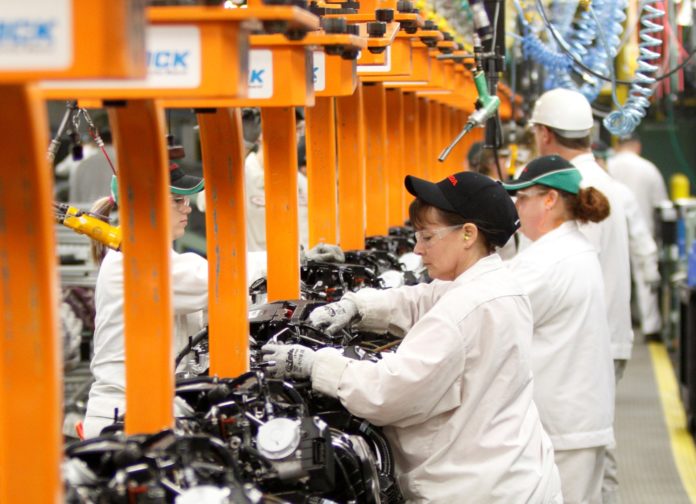
By Al Bredenberg, Senior Writer
In recent months, the U.S. auto industry has been sweating it out over a potential trade war emerging between the United States and, well, just about everybody else.
In March 2018, the Trump administration began imposing steel and aluminum tariffs. Following this, the White House threatened new tariffs on automotive imports. How might these trade protections affect the U.S. economy, and particularly the country’s automotive industry?
One of the most obvious and immediate effects will be felt in a rise in the cost of materials. Tariff-driven cost increases for imported metals would allow domestic producers to impose higher prices on American manufacturers. In fact, the steel tariff already seems to be causing a surge in U.S. steel prices. Focus Economics wrote that the price for U.S. hot-rolled coil (HRC) steel on June 1 “was 4.5 percent higher than on the same day in May,” was up 44.5 percent year-to-date, and “was 53.8 percent higher than on the same day last year.”
U.S. Commerce Secretary Wilbur Ross has shrugged off concerns about rising steel costs. In an interview with CNBC, Ross put the added cost of tariffs at $175 per car, telling interviewers:
“There’s about one ton of steel in a car, and the price of a ton of steel is $700 or so. So 25 percent of that would be a one half of one percent price increase, on a typical $35,000 car. So it’s no big deal.”
However, auto-industry experts agree that a tariff on automotive imports would definitely be a “big deal.” If the risks are high, what is the president’s justification for protectionist measures?
Tariffs: What’s the Rationale?
In March of 2018, President Trump announced his intention to impose a 25 percent tariff, or rate of duty, on imported steel and aluminum articles. By June 1, tariffs were in place on all such items, apart from exemptions given to a few countries.
The Trump administration justified this restriction on imports based on reports from Commerce Secretary Ross on January 11 and January 17 on the effects of steel and aluminum imports on U.S. national security. Section 232 of the Trade Expansion Act of 1962, sometimes called the “national security clause,” allows the president to “take such action, and for such time, as he deems necessary to adjust the imports of such article and its derivatives so that such imports will not so threaten to impair the national security.”
The Secretary’s investigation found that domestic steel production and “a healthy and competitive U.S. industry are essential to national security, considering both defense and infrastructure needs.” The U.S. is the world’s largest steel importer, and the report claimed that “In the first ten months of 2017, steel imports … increased at a double-digit rate over 2016, accounting for more than 30 percent of U.S. consumption.” Steel imports are nearly four times exports and “are priced substantially lower than U.S.-produced steel.” The shift toward imported steel has resulted in U.S. mill closures and a decline in industry employment, the report said.

The Secretary recommended that the White House impose quotas or tariffs that would allow U.S. producers to operate at 80 percent capacity or greater.
The Secretary’s report and recommendations on aluminum rested on a similar national-security justification.
Attacking Automotive Imports: A Bridge too Far?
Administration statements have expressed concern over “America’s more than $500 billion annual global trade deficit in goods and services,” and automotive imports figure large in those concerns.
Complaining about the U.S.’s $64 billion annual trade deficit with Germany, Peter Navarro, assistant to the President for trade and manufacturing policy, wrote in June:
“Even when Germany’s automakers build facilities in the United States, these so-called factories are more like assembly plants. SUVs in the BMW X series that are assembled in the United States actually contain only 25 percent to 35 percent American-built content — the high-value engines and transmissions are manufactured in Germany and Austria.”
Navarro cited America’s $70 billion trade deficit with Japan and said:
“For every one car America exports to Japan, Japan sends us over one hundred. High non-tariff barriers, including a complex regulatory system, make it difficult to sell American cars in Japan.”
Navarro argued that “American tariffs are among the lowest in the world” and that the country’s “generosity and free market good will has only led to a huge trade deficit and the transfer of wealth abroad.”
On May 23, 2018, President Trump directed Secretary of Commerce Ross to launch a Section-232 investigation into imports of automobiles and auto parts into the U.S. As with steel and aluminum, the results of the investigation hinge on the question of national security.
The U.S. automotive industry was less than sanguine about this step.
“The national-defense rationale is a fairly ingenious way to approach the steel and aluminum issue,” said Charles Chesbrough, senior economist with Cox Automotive, in an interview with Dealer News Today. “It’s a fairly easy argument to make. We have to have steel and aluminum in the United States. But I don’t see how the argument works when looking at automobiles.”
NADA President and Chairman Wes Lutz agrees with Trump’s concerns over the trade deficit and the loss of American manufacturing jobs. However, in a statement from the organization, he insisted that auto import tariffs would only do harm:
“The notion that there are truly ‘domestic’ and ‘international’ brands simply isn’t true any longer. Manufacturers are globally integrated, and their supply chains routinely span international boundaries. In fact, many international-brand vehicles are assembled in the U.S. with mostly American-made parts, while some domestic brands have models that are manufactured abroad and imported here. Consequently, some domestic brands could get hit harder with tariffs than some international brands.
“More to the point, though, it’s our customers who would feel the most dramatic effect of broad import tariffs through a combination of higher prices and fewer choices, as all imported vehicles and even U.S.-built vehicles get dramatically more expensive, and some imported models are no longer offered for sale in the U.S. altogether.”
The Association of Global Automakers openly scoffed at the national-security justification for an auto imports tariff. In a position paper, the organization quipped:
“America does not go to war in a Ford Fiesta.”
The Trade War’s War of Words
President Trump sees his emerging trade-protection regime as an expression of his chief foreign policy theme, “putting America first.” In 2016, during the U.S. presidential campaign, Trump said:
“My foreign policy will always put the interests of the American people, and American security, above all else. That will be the foundation of every decision that I will make. ‘America First’ will be the major and overriding theme of my administration.”
However, few economists seem to agree with tariffs as a solution to the U.S.’s trade deficits and the decline of its manufacturing sector.
The news service Reuters recently surveyed 60 economists, none of whom believed that the steel and aluminum tariffs would benefit the U.S. economy. Eighty percent thought the tariffs would do more harm than good, and the remaining respondents said they would have no effect or very little.
Cox’s Chesbrough wonders whether Trump’s approach is more strategic or tactical.
“On the one hand, it’s an interesting time to come after the automotive industry,” he told Dealer News Today. “It’s another great year for both new and used vehicle sales. You could make the argument that when things are going well could be the time to have these restrictions.”
“On the other hand,” he said, “maybe the President is going with a sort of ‘crazy-man’ approach, doing what nobody thinks you could get away with. You take an extreme position and scare people into making concessions. Only thing is, you have to see it through, you have to follow it all the way to the end.”

Chesbrough thinks that it could take a long time to judge those results, given the realities of the automotive industry.
“Almost immediately we’d begin to see a decline in employment,” he said. “It would be a long time before we’d see any increase in manufacturing jobs. For car dealerships around the country and their employees, the demand for vehicles would decline. That’s just the price effect.”
Chesbrough admitted that the President’s rhetoric resonates for many Americans.
“‘America First’ is a very easy concept for Americans to accept. All of us can agree that we want a strong, healthy country. It seems to me, though, that for President Trump, the proof is in the pudding. Does all this chaos and uncertainty lead to results?”












